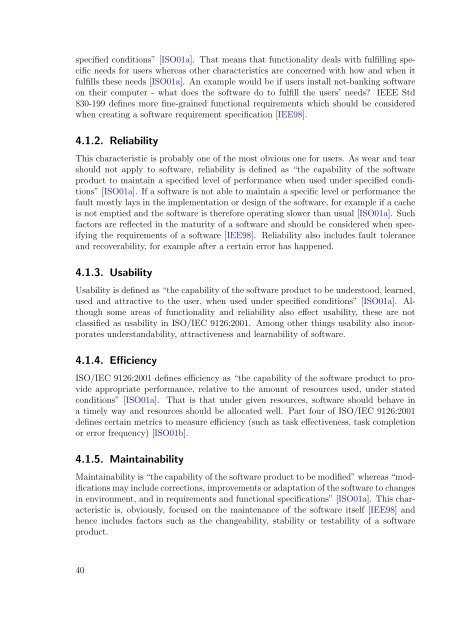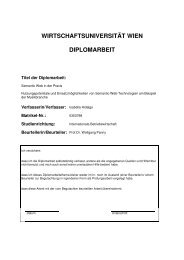Wirtschaftsuniversität Wien Magisterarbeit - SemanticLab
Wirtschaftsuniversität Wien Magisterarbeit - SemanticLab
Wirtschaftsuniversität Wien Magisterarbeit - SemanticLab
Create successful ePaper yourself
Turn your PDF publications into a flip-book with our unique Google optimized e-Paper software.
specified conditions” [ISO01a]. That means that functionality deals with fulfilling specific<br />
needs for users whereas other characteristics are concerned with how and when it<br />
fulfills these needs [ISO01a]. An example would be if users install net-banking software<br />
on their computer - what does the software do to fulfill the users’ needs? IEEE Std<br />
830-199 defines more fine-grained functional requirements which should be considered<br />
when creating a software requirement specification [IEE98].<br />
4.1.2. Reliability<br />
This characteristic is probably one of the most obvious one for users. As wear and tear<br />
should not apply to software, reliability is defined as “the capability of the software<br />
product to maintain a specified level of performance when used under specified conditions”<br />
[ISO01a]. If a software is not able to maintain a specific level or performance the<br />
fault mostly lays in the implementation or design of the software, for example if a cache<br />
is not emptied and the software is therefore operating slower than usual [ISO01a]. Such<br />
factors are reflected in the maturity of a software and should be considered when specifying<br />
the requirements of a software [IEE98]. Reliability also includes fault tolerance<br />
and recoverability, for example after a certain error has happened.<br />
4.1.3. Usability<br />
Usability is defined as “the capability of the software product to be understood, learned,<br />
used and attractive to the user, when used under specified conditions” [ISO01a]. Although<br />
some areas of functionality and reliability also effect usability, these are not<br />
classified as usability in ISO/IEC 9126:2001. Among other things usability also incorporates<br />
understandability, attractiveness and learnability of software.<br />
4.1.4. Efficiency<br />
ISO/IEC 9126:2001 defines efficiency as “the capability of the software product to provide<br />
appropriate performance, relative to the amount of resources used, under stated<br />
conditions” [ISO01a]. That is that under given resources, software should behave in<br />
a timely way and resources should be allocated well. Part four of ISO/IEC 9126:2001<br />
defines certain metrics to measure efficiency (such as task effectiveness, task completion<br />
or error frequency) [ISO01b].<br />
4.1.5. Maintainability<br />
Maintainability is “the capability of the software product to be modified” whereas “modifications<br />
may include corrections, improvements or adaptation of the software to changes<br />
in environment, and in requirements and functional specifications” [ISO01a]. This characteristic<br />
is, obviously, focused on the maintenance of the software itself [IEE98] and<br />
hence includes factors such as the changeability, stability or testability of a software<br />
product.<br />
40





